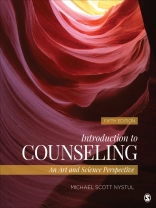Introduction to Counseling provides an overview of counseling and the helping professions from the perspective of art and science—the science of counseling that generates a knowledge base proven to promote competency and efficacy in the practitioner, and the art of using this knowledge base to build skills that can be applied sensitively to clients in a multicultural society.
The
Fifth Edition has been organized into three sections: (1) an overview of counseling and the counseling process, (2) multicultural counseling and counseling theories, and (3) special approaches and settings. It continues to address key topics and issues, including gender, culture, and sexual orientation, and offers ways to integrate multiculturalism into all aspects of counseling, rather than view it as a separate entity. Highlighting emerging trends and changes in ethical codes, as well as reflecting the latest updates to the Diagnostic Statistical Manual (DSM-5), the book successfully illustrates the importance of art and science to modern-day counseling.
Cuprins
Part I. An Overview of Counseling and the Counseling Process
Chapter 1: An Overview of Counseling
Welcome to the Field of Counseling
What Is Counseling?
Counseling: Past, Present, and Future
Chapter 2: Professional Preparation and Ethical and Legal Issues
Becoming a Professional Counselor
Ethical-Legal Issues
Chapter 3: The Counseling Process
The Art and Science of the Counseling Process
The Six Stages of the Counseling Process
Listening Skills
Recent Trends in the Counseling Process
Common Problems for Beginning Counselors
Diversity Issues
Chapter 4: Assessment and Diagnosis
The Art and Science of Assessment and Diagnosis
Assessment and Diagnosis
Assessment
Diagnosis
Chapter 5: Counseling Research and Evaluation
The Art and Science of Research and Evaluation
The Purpose of Research and Evaluation
Overview of the Types of Research
Part II. Developing a Personal Approach to Counseling from a Multicultural Perspective
Chapter 6: Developing a Personal Approach to Counseling from a Multicultural Perspective
The Art and Science of Developing a Personal Approach to Counseling from a Multicultural Perspective
Developing a Personal Approach to Counseling
An Eight-Stage Model for Developing a Personal Approach
Multicultural Counseling
Potential Challenges in Multicultural Counseling
Suggestions for Incorporating a Multicultural Perspective
Chapter 7: The Classic Theories of Freud, Adler, and Jung
The Art and Science of the Classic Theories
An Overview of Freud, Adler, and Jung
Freud’s Psychoanalytic Theory
Adler’s Individual Psychology
Jung’s Analytic Psychology
The Classic Theories and Their Use in Contemporary Practice
Chapter 8: Experiential Theories and Approaches
The Art and Science of Experiential Counseling
Experiential Counseling
Experiential Theories
Person-Centered Therapy
Gestalt Therapy
Existential Therapy
Creative Arts Therapy
Research Trends in Experiential Counseling
Chapter 9: Cognitive–Behavioral Theories
The Art and Science of Cognitive-Behavioral Counseling
Cognitive–Behavioral Theories
Behavior Therapy
Rational–Emotive Behavior Therapy (REBT)
Cognitive Therapy
Transactional Analysis (TA)
Reality Therapy
Feminist Therapy
Special Issues in Cognitive-Behavioral Counseling
Part III. Special Approaches and Settings
Chapter 10: Marriage and Family Counseling
The Art and Science of Marriage and Family Counseling
Evolution of Marriage and Family Counseling
Professional Issues and Organizations
Theoretical Foundations
Marriage Counseling
Family Counseling
Chapter 11: Child and Adolescent Counseling
The Art and Science of Child and Adolescent Counseling
Children and Adolescents from a Historical Perspective
Developmental Theories
Treatment Issues
Special Problems of Children and Adolescents
Diversity and Postmodern Issues in Child and Adolescent Counseling
Chapter 12: Group Counseling
The Art and Science of Group Counseling
Group Counseling
Group Counseling from a Historical Perspective
Comparison to Individual and Family Counseling
Problem Solving and Group Process
Group Size, Composition, and Duration
Use of Coleaders
Pregroup Screening and Orientation
Stages in Group Counseling
Brief-Solution-Focused Group Counseling
Dealing with Disruptive Group Members
Common Mistakes of Group Leaders
Qualities of Effective Group Leaders
Diversity Issues
Chapter 13: Career Counseling
The Art and Science of Career Counseling
Evolution of Career Counseling
Theoretical Foundations
Treatment Issues
Special Issues
Diversity Issues in Career Counseling
Chapter 14: School Counseling
The Art and Science of School Counseling
A Comprehensive Developmental Model for School Counseling
Role and Function of School Counselors
Special Skills and Problems
Trends in School Counseling
Chapter 15: Mental Health Counseling
The Art and Science of Mental Health Counseling
Professional Issues
The Role and Function of Mental Health Counselors
Categories of Mental Health Services
Strategies for Suicidal Clients
Substance Abuse Counseling
Gerontological Counseling
Trends and Perspectives
Despre autor
Michael S. Nystulreceived his Ph.D. in counseling from Oregon State University in 1974. He holds the position of Professor Emeritus in the Department of Counseling and Educational Psychology at New Mexico State University. Professor Nystul is a licensed psychologist and school psychologist. He has worked in a variety of clinical settings such as schools, hospitals, community mental health centers, university counseling centers, and private practice. His first position was an elementary and middle school counselor with the Bureau of Indian Affairs in 1970. He continues to be active in the counseling field and currently provides counseling and psychological services in private practice in Las Cruces, New Mexico. Professor Nystul has more than 100 publications, including journal articles, book chapters, and books to his credit. He has three daughters, five grandchildren, one great-grandchild, and relies on his wife, Laura, to maintain a sense of balance in life.












